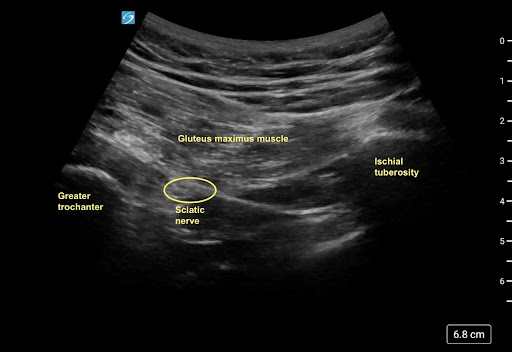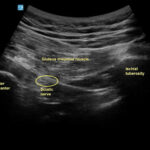Ultrasound Guided Transgluteal Sciatic Nerve Block for Refractory Sciatica in the Emergency Department
Case
A 50-year-old male presents to the emergency department with low back pain. He describes a history of chronic low back pain that has been progressively worsening lately. Pain is a sharp, shooting pain that radiates down his right leg and worsens with movement and ambulation with some associated numbness in the same area. The patient had to be wheeled into his room due to the severity of the pain. He reports no issues with bowel or bladder function, numbness in the groin, fevers, or chills. Vital signs are normal, and the physical exam reveals a positive straight leg raise test. The patient receives multiple rounds of multimodal pain management without significant relief of his symptoms. He remains unable to ambulate largely due to the severity of his pain. You perform an ultrasound guided nerve block in an attempt to control his pain enough to be able to discharge the patient home.
Description
Supplies:
- Ultrasound machine with curvilinear transducer
- Sterile probe cover with sterile gel
- Chlorhexidine prep stick
- Sterile gloves and drapes
- 10-20 mL of bupivacaine 0.5% (5 mg/mL; maximum 2 mg/kg). 4-8 mg dexamethasone may be added to reduce rebound symptoms.
- 20-22 gauge spinal needle (90 mm)
- Extension tubing up to 90 cm
- Lidocaine and 27 gauge needle for superficial skin wheal
Procedure:
- Be aware of signs and symptoms of local anesthetic systemic toxicity (LAST) and have Intralipid therapy readily available.
- Obtain consent. Perform pre-procedure time out.
- Position the patient in lateral decubitus position with the affected side exposed. Flex the affected leg so the knee and hip lie at 90°.
- Palpate the greater trochanter and the ischial tuberosity. Place the curvilinear probe along the line connecting these two landmarks with the indicator pointed toward the greater trochanter.
- Identify the structures on ultrasound including the greater trochanter and ischial tuberosity with the hyperechoic sciatic nerve bundle in between. The gluteus maximus muscle lies superficially, and the quadratus femoris muscle lies deep to the sciatic nerve (Fig 1).
- Administer a small superficial skin wheal of lidocaine near the planned insertion site.
- Prep the area with a chlorhexidine swab. Drape the area with sterile towels and open supplies into the sterile field. Don sterile gloves and place the sterile probe cover over the curvilinear probe.
- Using an in-plane approach technique, advance the spinal needle toward the sciatic nerve. As the needle is advanced, adjust the probe until the needle and its tip are visualized.
- Once the needle tip is adjacent to the sciatic nerve, aspirate to ensure no blood return.
- Have a non-sterile assistant inject 1mL of bupivacaine to ensure adequate positioning of the needle tip via hydrodissection of the fascial plane from the sciatic nerve.
- Inject 4-5 mL of bupivacaine, then readjust the needle to the far side of the sciatic nerve, aspirate and inject the remaining bupivacaine.

Fig 1. Ultrasound anatomy of sciatic nerve with structures as labeled.
Discussion
Low back pain is one of the leading causes of disability worldwide, and there are approximately 2.7 million annual visits to the emergency department (ED) in the United States for this chief complaint. [1] According to one retrospective study on these presentations, sciatica accounts for up to a third of these visits. [2] Once more emergent etiologies of low back pain have been ruled out, either via history and physical exam, or by various diagnostic modalities, the focus turns toward treatment of the pain both in the ED and once discharged. Many studies have been conducted focusing on the efficacy of various pharmacologic therapies including non-steroidal anti-inflammatory drugs (NSAIDs), acetaminophen, muscle relaxants, glucocorticoids, lidocaine patches, opiates, combination therapy, and more. [3] NSAIDs are the first-line pharmacologic therapy as a 2020 Cochrane review did show some benefit in patients with acute low back pain. [4] Opiates are commonly used in the acute setting in the ED, but there is limited data supporting their use, and their side effects and abuse potential limit their utility.
The ultrasound guided transgluteal sciatic nerve block as described here provides ED physicians with an additional treatment option in patients who present with low back pain related to sciatica. This technique has been used previously by anesthesia for pain management surrounding lower extremity orthopedic or podiatric surgeries, but it has only just recently been introduced to emergency medicine. It was first described for use in refractory low back pain in the ED in 2019 and a subsequent case series demonstrating safety and efficacy was published in 2020. [5] This block results in a motor and sensory block of the posterior thigh and below the knee except for the medial leg and foot. In the hands of a trained practitioner, this technique can be a useful tool to treat refractory low back pain due to sciatica and may help avoid unnecessary hospital admissions and possibly reduce long term disability as well. ■
References:
- Friedman BW, Chilstrom M, Bijur PE, Gallagher EJ. Diagnostic testing and treatment of low back pain in United States emergency departments: a national perspective. Spine (Phila Pa 1976). 2010;35(24):E1406–11.
- Nunn ML, Hayden JA, Magee K. Current management practices for patients presenting with low back pain to a large emergency department in Canada. BMC Musculoskelet Disord. 2017 Feb 23;18(1):92. doi: 10.1186/s12891-017-1452-1. PMID: 28228138; PMCID: PMC5322663.
- Gillespie, Lauren, et al. “Back to Basics: Treatment of Acute Low Back Pain in the ED.” Taming the SRU, 1 Sept. 2020. Access at: www.tamingthesru.com/blog/diagnostics/back-pain.
- van der Gaag WH, Roelofs PD, Enthoven WT, van Tulder MW, Koes BW. Non-steroidal anti-inflammatory drugs for acute low back pain. Cochrane database Syst Rev. 2020;4(4):CD013581. doi:10.1002/14651858.CD013581
- Goldsmith AJ, Liteplo A, Hayes BD, Duggan N, Huang C, Shokoohi H. Ultrasound-guided transgluteal sciatic nerve analgesia for refractory back pain in the ED. Am J Emerg Med. 2020 Sep;38(9):1792-1795. doi: 10.1016/j.ajem.2020.06.001. Epub 2020 Jun 6. PMID: 32738473.
- Fang, J., Shi, Y., Du, F. et al. The effect of perineural dexamethasone on rebound pain after ropivacaine single-injection nerve block: a randomized controlled trial. BMC Anesthesiol 21, 47 (2021). https://doi.org/10.1186/s12871-021-01267-z
- Atchabahian, Arthur, et al. “Ultrasound-Guided Sciatic Nerve Block.” NYSORA, 28 Apr. 2022. Access at: www.nysora.com/topics/regional-anesthesia-for-specific-surgical-procedures/lower-extremity-regional-anesthesia-for-specific-surgical-procedures/foot-and-anckle/ultrasou nd-guided-sciatic-nerve-block-2/





